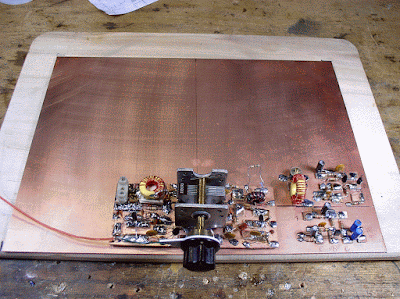A while back Bob N7SUR got us talking about winter projects. Receivers. Of course, Pete and I quickly went down different paths. Pete is making great progress with lots of interesting digital circuitry. He is going over to the dark side. Check it out here:
I went with simplicity. Extreme simplicity. Direct Conversion (thanks Wes!). Discrete components. No chips. Analog Oscillator. 40 meters -- monoband.
 |
| Schematic updated 29 November 2017 |
There it is. You can click on the picture to make it larger. Here is an outline of the circuitry:
-- Single tuned circuit bandpass filter preceded by a simple pot that serves as a gain control.
-- JFET RF amp
-- Singly balanced passive mixer inspired by F5LVG's RX-20 in SPRAT 100. For the coil I used one of the many trifilar toroids that Farhan gave me.
-- The local oscillator is the coolest stage. I used a 7.37 MHz ceramic resonator and a circuit inspired by Miguel PY2OHH. With a polivaricon I can tune the entire 40 meter band. I put a reduction drive int here to make tuning easier.
-- The AF amp is an op-amp free design. It works well into ear buds or into a computer speaker.
-- Perhaps in an effort to catch the attention of the younger generation, I built it into an iPhone box.
Please let me know if you spot any flaws in the circuit, or see any places where it might be improved.
More to follow. This prototype is now in the mail, en route to my nephew John Henry who will be testing it for me.









































